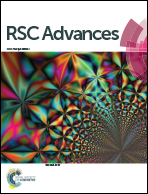Facile synthesis of nitrogen-doped carbon derived from polydopamine-coated Li3V2(PO4)3 as cathode material for lithium-ion batteries†
Abstract
Nitrogen-doped, carbon-coated Li3V2(PO4)3 cathode materials were prepared by the oxidative self-polymerization of dopamine on the Li3V2(PO4)3 surface and subsequent carbonization of polydopamine. Field emission scanning electron microscopy (FESEM), scanning transmission electron microscopy-energy dispersive X-ray spectroscopy (STEM-EDS) and X-ray photoelectron spectroscopy (XPS) were performed to characterize morphologies and structures. The uniform nitrogen-doped, carbon coating provided a continuous electronic conducting network. Furthermore, the existence of nitrogen in the composite can improve electronic conductivity. As cathode materials for lithium-ion batteries, the nitrogen-doped, carbon-coated Li3V2(PO4)3 composites display superior rate performance and excellent cycle performance over the pristine Li3V2(PO4)3 and carbon-coated Li3V2(PO4)3. The electrode delivers high specific capacity of 74 mA h g−1 at 10 C, and still remains at 95.4% of initial capacity after 100 cycles at 1 C.

- This article is part of the themed collection: Materials for Energy storage

 Please wait while we load your content...
Please wait while we load your content...